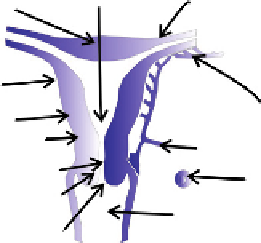Biomedical Engineering Reference
In-Depth Information
Figure 12.7
Frontal sections through the
uterus and upper part of the vagina.
Cavity
Lateral cornu
Fundus
Body
Isthmus
Internal OS
Cervical canal
Lateral fornix
Ovarian artery
Urinary artery
Ureter
Vagina
External OS
From a histological perspective, the uterine tissue consists of three well-defined
layers: the tunica serosa (perimetrium), the tunica muscularis (myometrium), and
the tunica mucosa and submucosa (endometrium). The tunica mucosa is the muco-
sal lining of the uterus, consisting of epithelial tissue, tubular glands, and connec-
tive stroma tissue. Hormonal changes associated with the menstrual cycle cause the
superficial two-thirds surface of the endometrium (also known as the functionalis or
stratum functionale) to be sloughed in a process known as menstruation. However,
the basalis (or stratum basale) component of the endometrial layer remains intact and
permits regeneration of the sloughed funtionalis layer. The highly vascularized tunica
muscularis consists of a thick inner circular layer and a thinner outer longitudinal
layer of smooth muscle. The region in between the two layers of smooth muscle con-
tains large blood vessels. The tunica serosa consists of loose connective tissue con-
taining a large number of lymphatic vessels.
Clinically, the oral route is the most accepted and common way for delivering drugs
having relatively low molecular mass of up to 400-600 Da. As high-molecular-weight
drugs are poorly absorbed by the digestive tract
[148]
, they must be delivered parenter-
ally in order to obtain therapeutic effect. Due to enzymatic degradation in the intestinal
lumen, enterocytes, or liver (first-pass effect), and/or a low permeability of the intesti-
nal epithelia, many low-molecular-weight drugs must also be delivered parenterally. In
these cases, alternative routes can be selected when even parenteral route is not feasible.
The design of delivery systems for peptides and proteins and their evaluation
depends on physicochemical and biological properties, and the pharmacokinetics and
pharmacodynamics of the substance itself. The desire to deliver protein and peptide
biopharmaceuticals suitably and efficiently has led to extensive study of site-specific
drug-delivery systems. Despite challenges, progress toward the convenient noninva-
sive delivery of proteins and peptides has been achieved through specific routes of
administration. In addition, the delivery of proteins and peptides to specific sites of
action has been exploited to reduce the total dose to be delivered; gain access to spe-
cific organs or body compartments; and concentrate a therapeutic dose at a specific
site of pharmacological action. The delivery pattern is vital for the pharmacologi-
cal result of diverse peptide and protein drugs. Pulsatile release rather than constant
release may be needed for several drugs with regulatory functions. Dosing at steady
state of several drugs could lead to tolerance, or “downregulation” of receptors due to

Search WWH ::

Custom Search